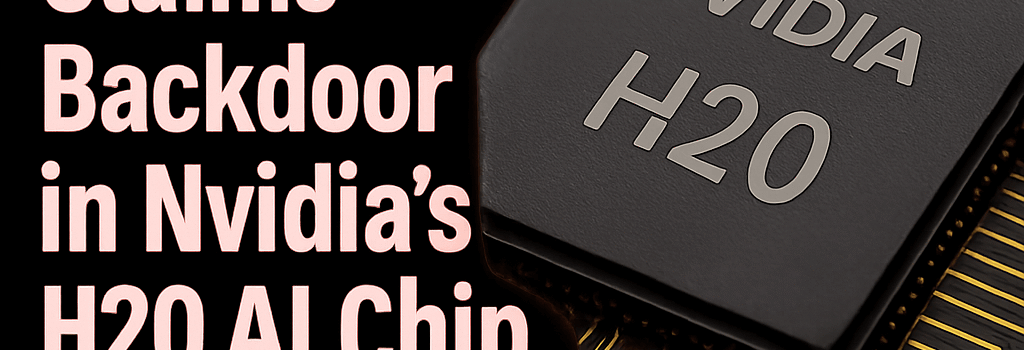China Claims Backdoor in Nvidia’s H20 AI Chip for Market

Background of the Dispute
In late July 2025, China’s Cyberspace Administration (CAC) publicly accused US semiconductor leader Nvidia of embedding a covert backdoor into its H20 artificial intelligence accelerator, a chip specifically modified to satisfy US export controls. This development comes after Washington reversed a prior ban, permitting H20 exports to China under tightened licensing conditions.
“US AI experts revealed that Nvidia’s computing chips have location-tracking capabilities and can remotely shut down on command,” the CAC statement read.
- Location-tracking firmware allegedly reports geographic coordinates back to Nvidia.
- Remote disable commands purportedly reside in a secure enclave within the chip’s management controller.
- US lawmakers are simultaneously proposing geo-fencing requirements for export-controlled semiconductors.
Official Meeting with Cyberspace Administration of China
On July 30, the CAC summoned Nvidia representatives to Beijing. The regulator demanded:
- Full disclosure of the H20’s security architecture and firmware update logs.
- Documentation proving compliance with China’s Multi-Level Protection Scheme (MLPS2.0).
- Third-party test results validating the absence of hidden interrupters or telemetry modules.
Nvidia has yet to publicly address these demands. Internally, the company maintains that all export-compliant chips run a stripped-down firmware image disabling advanced remote management features.
Technical Deep Dive: H20 Architecture and Security Mechanisms
The H20 builds on Nvidia’s Ampere-derived Blackwell microarchitecture with the following key specifications:
- Compute Units: 72 streaming multiprocessors (SMs) delivering up to 110 TFLOPS (FP16).
- On-Package Memory: 80 GB HBM3 @ 1.2 TB/s bandwidth.
- Secure Enclave: A dedicated management controller running TrustZone-style firmware, enforcing Secure Boot and encrypted boot chains.
- Firmware Update Channel: Over-the-air (OTA) signed updates via Nvidia’s global update servers.
Security experts note that geolocation checks—common in modern GPUs to enforce export rules—are typically performed by the baseboard management controller (BMC). Allegations suggest a hidden module in the H20’s secure enclave could trigger a hardware deadman switch if the chip reports an “unauthorized” region.
Geopolitical Implications and Supply Chain Risks
The spat underscores growing US-China tensions over advanced semiconductor trade. Key considerations include:
- Export Control Tightening: US Commerce Department’s recent rule requires enhanced due diligence and possible on-chip geo-fencing for Compute Express Link (CXL) capable devices.
- Domestic Substitution: Beijing has ordered state-owned enterprises and hyperscale cloud providers to accelerate adoption of indigenous AI accelerators, aiming for a 30% domestic share by 2026.
- Global Foundry Risks: Taiwan-based TSMC remains Nvidia’s sole 5 nm and 4 nm foundry partner, heightening geopolitical supply chain fragility.
Comparative Analysis with Domestic AI Chips
China’s leading vendors are racing to fill any void:
- Huawei Ascend 910: 256 TFLOPS FP16, 32 GB HBM2e, built on 7 nm process.
- Biren BR100: 90 TFLOPS FP16, 64 GB HBM3, featuring mesh-interconnect topology.
- Cambricon MLU270: 70 TFLOPS FP16, 32 GB HBM2, optimized for transformer inference.
While performance is converging, domestic solutions often lack mature software ecosystems (e.g., CUDA, cuDNN). Nvidia’s advantage remains its robust CUDA-X AI stack and broad industry support.
Expert Opinions and Outlook
Paul Triolo, partner at DGA-Albright Stonebridge, commented: “Without third-party verification, allegations of an intentional backdoor are speculative. But they highlight how security can become a geopolitical lever.”
On Capitol Hill, bipartisan support is growing for legislation mandating on-chip geo-fencing in export-controlled hardware. Proponents argue it mitigates unauthorized proliferation, though critics warn of potential misuse against legitimate customers.
Conclusions
The latest CAC allegations mark a new chapter in the high-stakes semiconductor rivalry between Washington and Beijing. With both sides escalating technical, regulatory, and political measures, global AI hardware supply chains face unprecedented complexity and uncertainty.